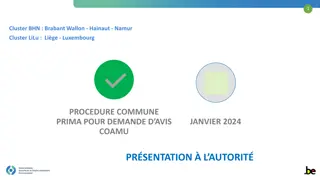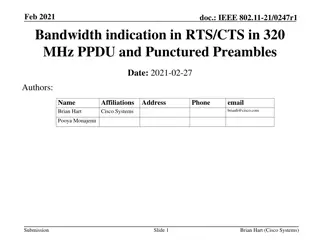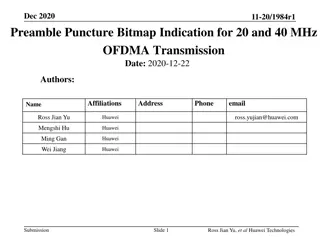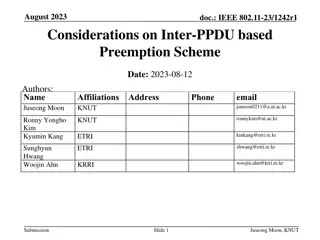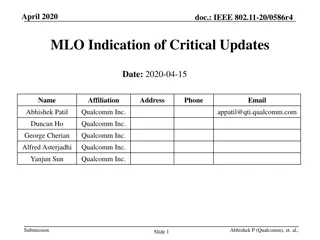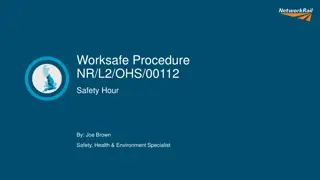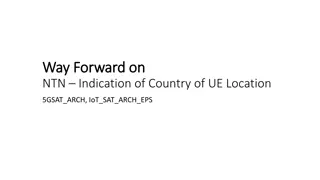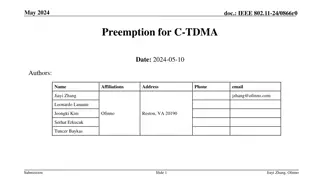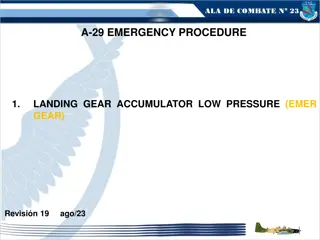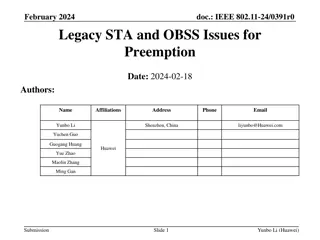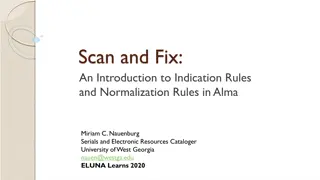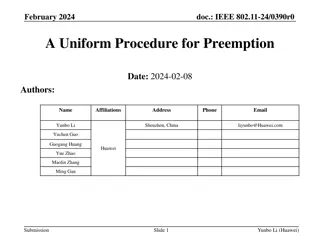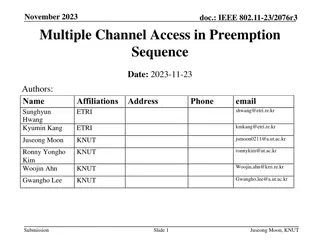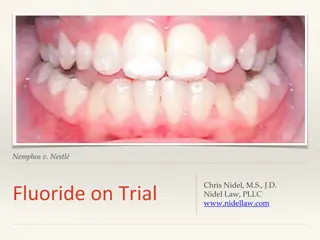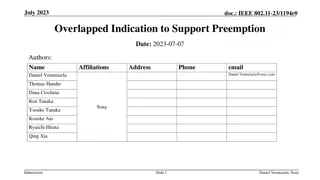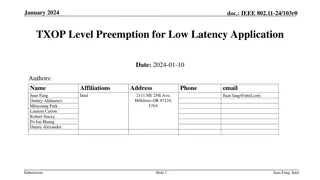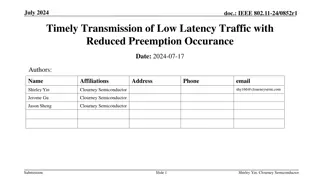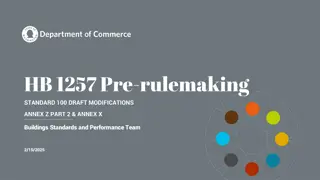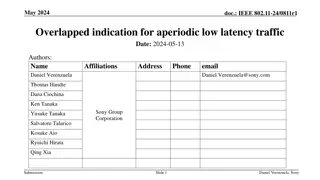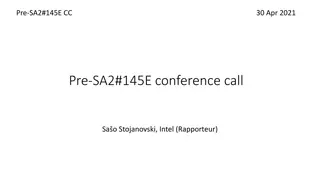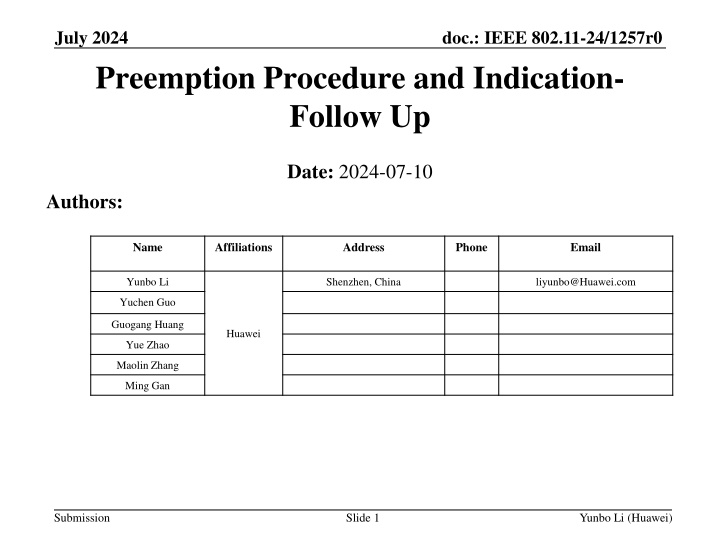
IEEE 802.11-24/1257r0 Preemption Procedure and Indication
Explore the proposed preemption procedures in IEEE 802.11-24/1257r0 document for managing low latency data transmissions. The document outlines preemption indications, design principles, and procedures to ensure efficient data delivery while balancing stakeholder requirements and minimizing signaling overhead.
Download Presentation

Please find below an Image/Link to download the presentation.
The content on the website is provided AS IS for your information and personal use only. It may not be sold, licensed, or shared on other websites without obtaining consent from the author. If you encounter any issues during the download, it is possible that the publisher has removed the file from their server.
You are allowed to download the files provided on this website for personal or commercial use, subject to the condition that they are used lawfully. All files are the property of their respective owners.
The content on the website is provided AS IS for your information and personal use only. It may not be sold, licensed, or shared on other websites without obtaining consent from the author.
E N D
Presentation Transcript
doc.: IEEE 802.11-24/1257r0 July 2024 Preemption Procedure and Indication- Follow Up Date: 2024-07-10 Authors: Name Affiliations Address Phone Email Yunbo Li Shenzhen, China liyunbo@Huawei.com Yuchen Guo Guogang Huang Huawei Yue Zhao Maolin Zhang Ming Gan Submission Slide 1 Yunbo Li (Huawei)
doc.: IEEE 802.11-24/1257r0 July 2024 Introduction There are a lot of discussion on the procedure of preemptions, they could be divided into two categories in high level Preemption allows for both the receiver STA and third party STAs; or, Preemption allows only for the receiver STA Some members concern about the preemption will affect the on-going transmission without the permission of the receiver STA; Some members want the receiver STA has higher priority to do preemption; In this proposal, a procedure is proposed which try to have a good balance among: Requirements from different members Flexibility Signaling overhead Submission Slide 2 Yunbo Li (Huawei)
doc.: IEEE 802.11-24/1257r0 July 2024 Design Principles When a STA has low latency traffic, it follows below priority to send the low latency data: TXOP holder > receiver STA > the third party STAs Flexible; Low signaling overhead Submission Slide 3 Yunbo Li (Huawei)
doc.: IEEE 802.11-24/1257r0 July 2024 Proposed Preemption Procedures A parameter Preemption Indication (PI) is carried in the frame from the TXOP holder PI = 0: preemption is not allowed PI = 1: only allows the receiver STA send low latency data to the TXOP holder PI = 2: allows the receiver STA send low latency data to the TXOP holder or a third party STA PI = 3: allows the receiver STA send low latency data to the TXOP holder or a third party STA, or allows a third party STA preempt A parameter Low Latency (LL) is carried in the frame from the receiver STA LL = 0: no low latency data LL = 1: has low latency data to the TXOP holder LL = 2: has low latency data to the TXOP holder or a third party STA Submission Slide 4 Yunbo Li (Huawei)
doc.: IEEE 802.11-24/1257r0 July 2024 Preemption Procedures When AP allows preemption at receiver STA side (PI = 1), and the receiver STA indicate pending low latency data to AP (LL=1), the receiver STA can directly transit the low latency data (PPDU2) to AP; When the receiver STA has more pending low latency data to AP, it will indicate LL=1 in the transmitting packet (see PPDU2), otherwise indicate LL=0 (see PPDU3); When AP receive a PPDU from the receiver STA with LL=0, the AP can indicate PI = 0 in the response frame (see BA3), and take back the TXOP; Same procedure can be used when a non-AP STA is the TXOP holder. PPDU4 BA2 (PI= 1) PPDU1 (PI = 1) BA3 (PI= 0) AP PPDU2 (LL= 1) BA1 (LL= 1) PPDU3 (LL= 0) STA1 Submission Slide 5 Yunbo Li (Huawei)
doc.: IEEE 802.11-24/1257r0 July 2024 Preemption Procedures When a non-AP STA allows AP to send low latency data to a third party STA (PI = 2), and the AP indicate pending low latency data to a third party STA (LL=2), the AP can directly transit the low latency data (PPDU2) to a third party STA; When the AP doesn t have more pending low latency data to the third party STA, it will send a PPDU to the TXOP holder and indicate LL=0 (see PPDU3) to return the TXOP to the TXOP holder. PPDU2 (LL= 2) BA1 (LL= 2) PPDU3 (LL= 0) AP PPDU4 PPDU1 (PI = 2) BA3 (PI= 0) STA1 BA2 STA2 Submission Slide 6 Yunbo Li (Huawei)
doc.: IEEE 802.11-24/1257r0 July 2024 Preemption Procedures When an AP indicates PI = 3 in a PPDU, and the receiver STA indicates no pending low latency data to AP (LL=0), the third party STAs can send PR frames to request for preemption; The AP will stop transmitting following PPDU2 if a PR frame is received SIFS after BA1, otherwise the AP will transmit PPDU2 PIFS after BA1. PIFS PPDU2 PPDU1 (PI = 3) AP BA1 (LL= 0) STA1 SIFS PR STA2 Submission Slide 7 Yunbo Li (Huawei)
doc.: IEEE 802.11-24/1257r0 July 2024 Preemption Procedures When an AP indicates PI = 3 in a PPDU, and the receiver STA indicates pending low latency data to AP (LL=1), the receiver STA will send low latency data (PPDU2) to AP; When no further low latency data to AP, the receiver STA can indicate LL=0 to AP. Then AP can indicate PI = 3 in the response frame (see BA2) to allow preemption from third party STAs; A third party STA is allowed to send PR to request preemption under this case. PIFS BA2 (PI= 3) PPDU2 PPDU1 (PI = 3) AP BA1 (LL= 1) PPDU2 (LL = 0) STA1 SIFS PR STA2 Submission Slide 8 Yunbo Li (Huawei)
doc.: IEEE 802.11-24/1257r0 July 2024 Proposed Preemption Procedures The parameter LL can further indicates the receiver STA s preference of preemption for the third party STAs; A parameter Low Latency (LL) indication can updated as below: LL = 0: no low latency data, and preemption is allowed LL = 1: has low latency data to the TXOP holder LL = 2: has low latency data to the TXOP holder or a third party STA LL = 3: preemption is not allowed Submission Slide 9 Yunbo Li (Huawei)
doc.: IEEE 802.11-24/1257r0 July 2024 Preemption Procedures The receiver STA can disallow preemption from a third party STA by indicate LL=3 in the response frame; When AP indicate PI=3 in a PPDU, even the receiver STA doesn t have pending low latency data, the receiver STA can indicate LL=3; The third party STAs are not allowed to send PR frame to request for preemption. SIFS PPDU2 PPDU1 (PI = 3) AP BA1 (LL= 3) STA1 SIFS PR STA2 Submission Slide 10 Yunbo Li (Huawei)
doc.: IEEE 802.11-24/1257r0 July 2024 Summary A preemption procedure is proposed for below purpose Give higher priority to the receiver STA compare with the third party STAs High flexibility Low signaling overhead Submission Slide 11 Yunbo Li (Huawei)
doc.: IEEE 802.11-24/1257r0 July 2024 SP1 Do you agree to adopt the preemption procedure illustrated from slide 4 to slide 8? Submission Slide 12 Yunbo Li (Huawei)


